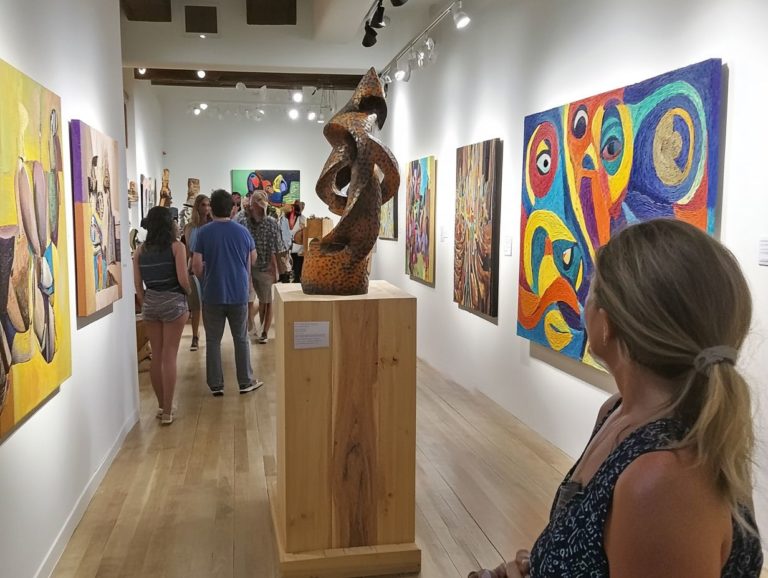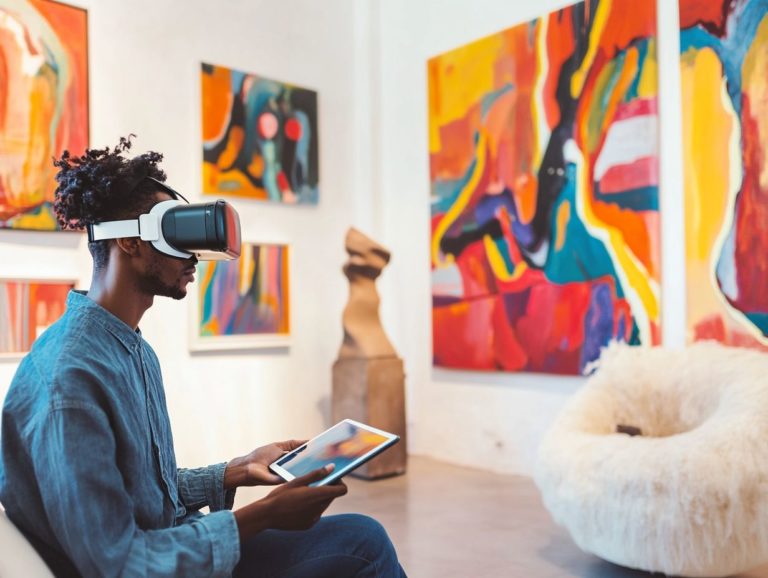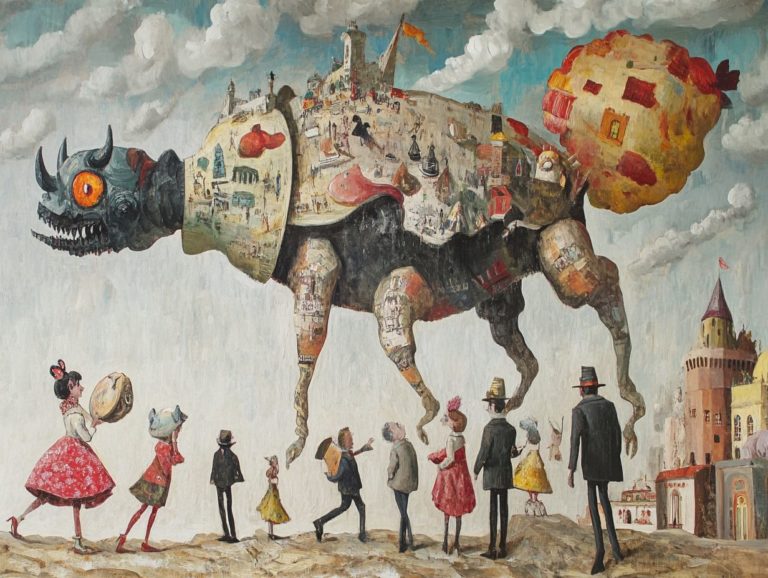The Art of Collecting: Balancing Passion and Profit
Collecting transcends mere hobby status; it emerges as an art form that beautifully marries passion with profit.
This article delves into the allure of collecting, exploring the profound emotional connections you forge with your items and the strategies to adeptly navigate the market. Whether you’re a seasoned collector or just embarking on this journey, you’ll discover how to harmonize your love for collecting with the potential for financial gain.
Furthermore, you’ll uncover valuable tips for curating and maintaining your collection. Prepare to step into the captivating world of collecting!
Contents
- Key Takeaways:
- The Passion of Collecting
- Turn Your Passion into Profit: The Business Side of Collecting
- Balancing Passion and Profit
- Tips for Successful Collecting
- Preguntas Frecuentes
- Qu es el arte de coleccionar?
- C mo se puede equilibrar la pasi n y el beneficio en la colecci n?
- Cu les son algunos errores comunes a evitar en la colecci n?
- C mo puede uno determinar el valor de su colecci n?
- Cu les son algunos consejos para vender una colecci n?
- C mo puede uno asegurar la preservaci n de su colecci n?
Key Takeaways:

Collecting is both an art and a business, requiring a balance between passion and profit. Understanding the market and considering factors such as rarity and demand are essential for profitable collecting. Successful collecting involves finding the sweet spot between collecting for joy and collecting for profit, and maintaining a well-curated collection.
The Passion of Collecting
The passion of collecting art transcends mere ownership; it’s about forging an emotional connection with the artworks that resonate profoundly with you. Regardless of the artistic styles or periods that capture your interest, this bond is what makes collecting special.
As the art market evolves, you may find yourself increasingly drawn to the historical significance of pieces. You invest not solely for their financial potential but also for the rich stories and sentiments embedded within each artwork.
This multifaceted approach underscores the importance of an artist’s reputation and a thoughtfully curated art portfolio, allowing you to build a collection that reflects your unique tastes while immersing yourself in a vibrant art community.
What Makes Collecting an Art?
Collecting art transcends the simple act of acquiring pieces; it evolves into an art form that demands a clear grasp of how to identify real artworks, market trends, and the financial potential that artworks possess.
To genuinely appreciate this endeavor, you must immerse yourself in the nuances of researching artists and their distinctive histories. This exploration goes far beyond the act of purchase; it involves examining the artistic movements that have shaped their work and the social and economic influences that impact their creations.
Verifying authenticity is a crucial responsibility, especially given the prevalence of fake artworks in the market. This reality often leaves collectors grappling with trust in provenance.
Furthermore, navigating market trends adds complexity to your journey shifts in taste can dramatically influence value. Thus, it becomes essential for you to remain informed and adaptable in your collecting pursuits.
The Emotional Connection
The emotional connection you have with artworks serves as a powerful driving force in the art market; it often transcends mere financial calculations, tapping into deeper sentiments tied to the artist’s reputation and the narrative that accompanies each piece.
This intrinsic bond can lead to impulsive purchases where personal resonance takes precedence over monetary value. Take, for example, the works of Frida Kahlo. Her vividly expressive paintings, reflecting her tumultuous life and profound emotional struggles, captivate viewers and encourage a personal attachment to her art.
Similarly, contemporary artists like Banksy elicit strong reactions through their provocative social commentary, making the acquisition of their work feel like more than just an investment; it becomes a statement about your identity and values.
These emotional undercurrents within the art market underscore the vital role of personal connection in shaping your decisions as a collector.
Turn Your Passion into Profit: The Business Side of Collecting
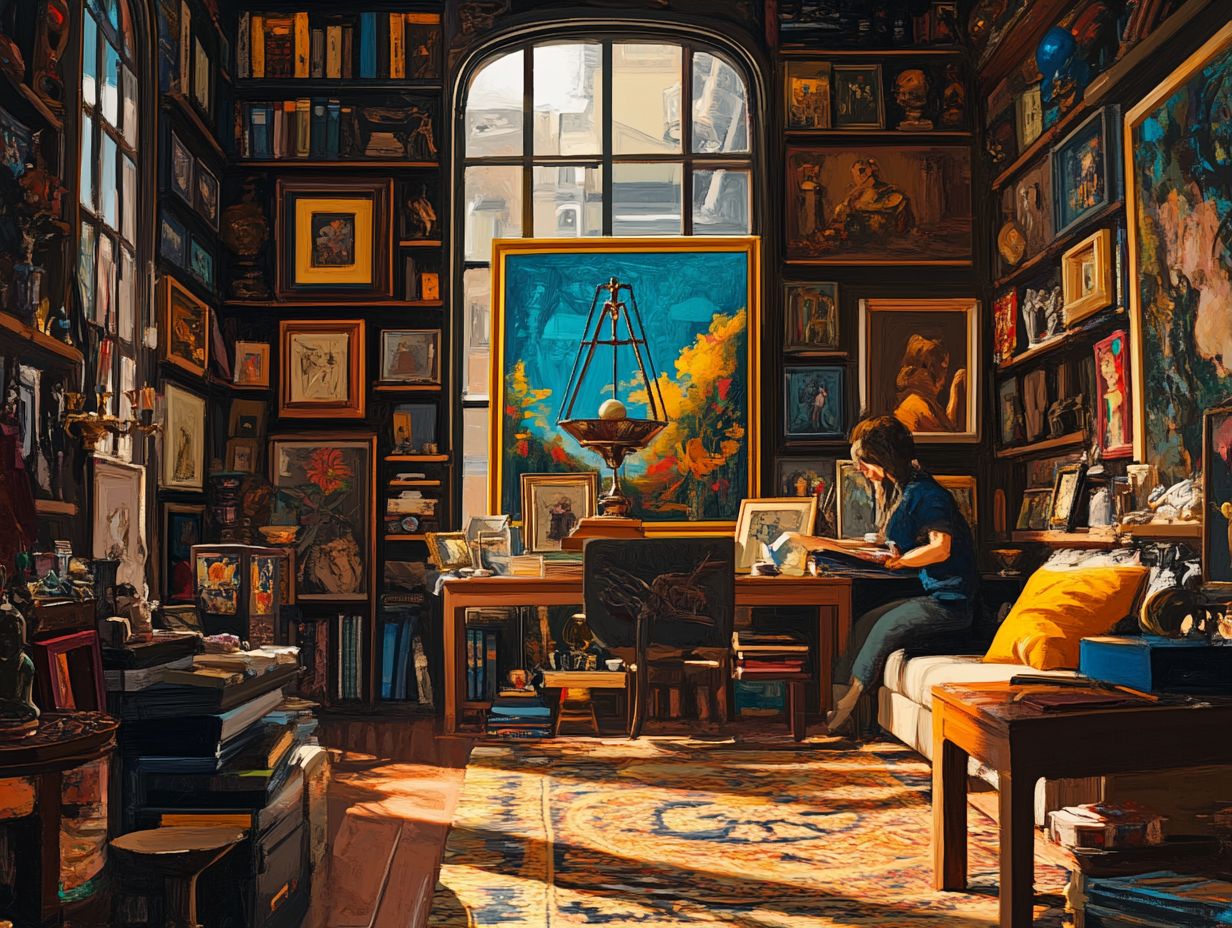
Navigating the art market is an exciting adventure that can lead to great rewards!
With informed investment decisions, significant financial rewards await those who possess a firm grasp of fundamental financial principles and effective pricing strategies.
Don’t wait! Dive into collecting today and discover the joys and potential profits waiting for you!
Understanding the Market
To successfully invest in art, you need to understand the current dynamics of the art market, along with its historical trends and methodologies for tracking performance over time. By immersing yourself in the fluctuations and patterns that define this unique sector, you can better anticipate future movements and make well-informed decisions.
Evaluating past performance indicators like auction results and collector interest provides invaluable insights that can inform your choices.
Utilizing effective market research techniques, such as:
- consulting art advisory firms,
- attending exhibitions,
- exploring online databases,
gives you the power to assess demand and accurately determine art value. Staying updated on art fair activities, contemporary piece trends, and the impact of economic factors on buyer behavior can ultimately lead to astute investments.
Factors to Consider for Profit
Consider factors that influence profitability in art collecting, including financial potential, negotiation skills, and crucial legal aspects, such as copyright and tax obligations.
Additionally, staying attuned to market trends and the insights of art advisors can offer you valuable perspectives on the nuances of the art market.
Mastering negotiation techniques can lead to substantial cost savings. A solid understanding of your legal rights ensures that your transactions are both smooth and compliant.
By partnering with art experts who can authenticate and assess the condition of pieces, you position yourself to make informed decisions that align with your financial aspirations.
By prioritizing these elements, you can cultivate a strategic approach that significantly enhances your investment outcomes.
Balancing Passion and Profit
Balancing passion and profit in art collecting is a complex task that demands your strategic investment decisions. It’s essential to build a real connection to the artworks while also considering the financial fundamentals and exploring the art market to enhance the diversity of your art portfolio.
By navigating this intricate landscape, you can create a collection that resonates personally and stands strong in an evolving market.
Finding the Sweet Spot
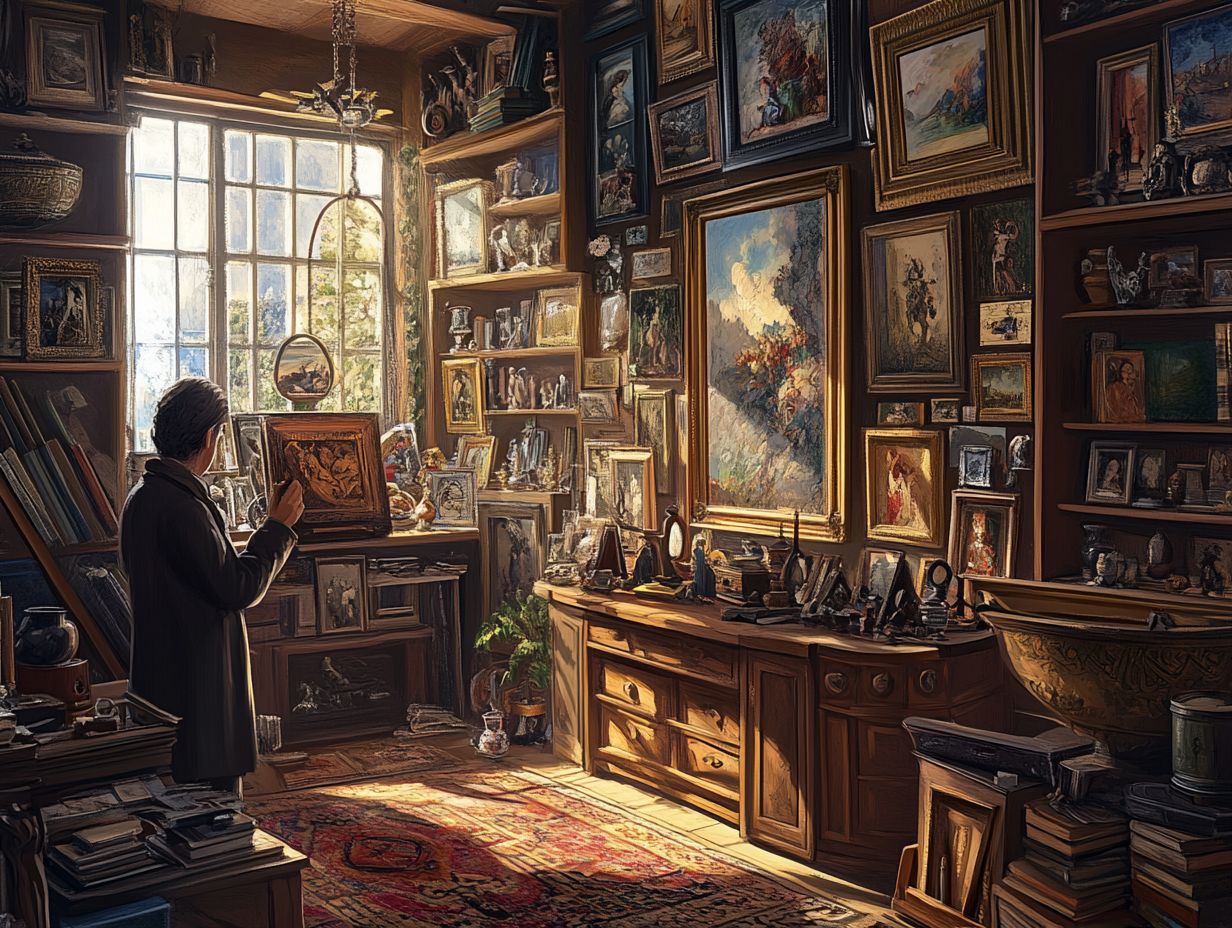
Finding the sweet spot in art collecting means striking a balance between investing in pieces by well-established artists and exploring diverse genres and mediums that align with current market trends.
As you broaden your focus, you might stumble upon unexpected gems, including lesser-known artists who evoke powerful emotions through their distinct styles.
Keeping an eye on how genres like abstract, contemporary, or traditional landscapes perform at auctions can offer valuable insights into which areas are ripe for appreciation. Monitor emerging mediums like digital art or installations for promising growth opportunities.
By weaving these considerations into your personal taste, you ll be better equipped to identify pieces that resonate with you while also holding intrinsic investment value.
Tips for Successful Collecting
Successful collecting demands a blend of meticulous research, thoughtful pricing strategies, and active engagement with the art community. This approach enables you to cultivate a well-rounded collection that mirrors your personal taste while maintaining financial viability.
Strategies for Finding and Evaluating Items
When you’re on the hunt for items to enhance your art collection, adopting a systematic approach is key. This means diving deep into research on artists, understanding market trends, and addressing authenticity issues. Such hard work helps you make informed purchasing decisions.
This process doesn’t just guarantee the quality of the artworks you acquire; it secures their long-term value and relevance within the contemporary art landscape. Leverage various tools, like online databases and art market reports, to uncover insights about artists’ backgrounds and career trajectories.
Engaging with reputable galleries and attending art fairs will immerse you in the experience of the works while enabling valuable conversations with industry professionals.
To grasp pricing strategies effectively, compare similar pieces, analyze auction results, and consult pricing guides. This approach will enhance your skills to assess the value of potential acquisitions, ultimately enriching your collecting journey.
Start your art journey today!
Maintaining a Collection
Maintaining your collection goes beyond just caring for the physical artworks. It also involves a thoughtful assessment of your art portfolio in relation to financial fundamentals. This helps you build a vibrant community and embrace diverse artists!
This active involvement keeps you engaged not only with the pieces you own but also with the wider art community. By employing preservation techniques like optimal lighting, keeping the right temperature and humidity, and routine inspections, you can guarantee the longevity of your collection.
Regularly reassessing what you possess allows you to make informed choices about potential acquisitions or sales. Cultivating relationships with local artists and actively participating in community events enriches your collection’s narrative. This vibrant mix has the power to invigorate your collection, inspiring continuous growth and discovery.
Preguntas Frecuentes
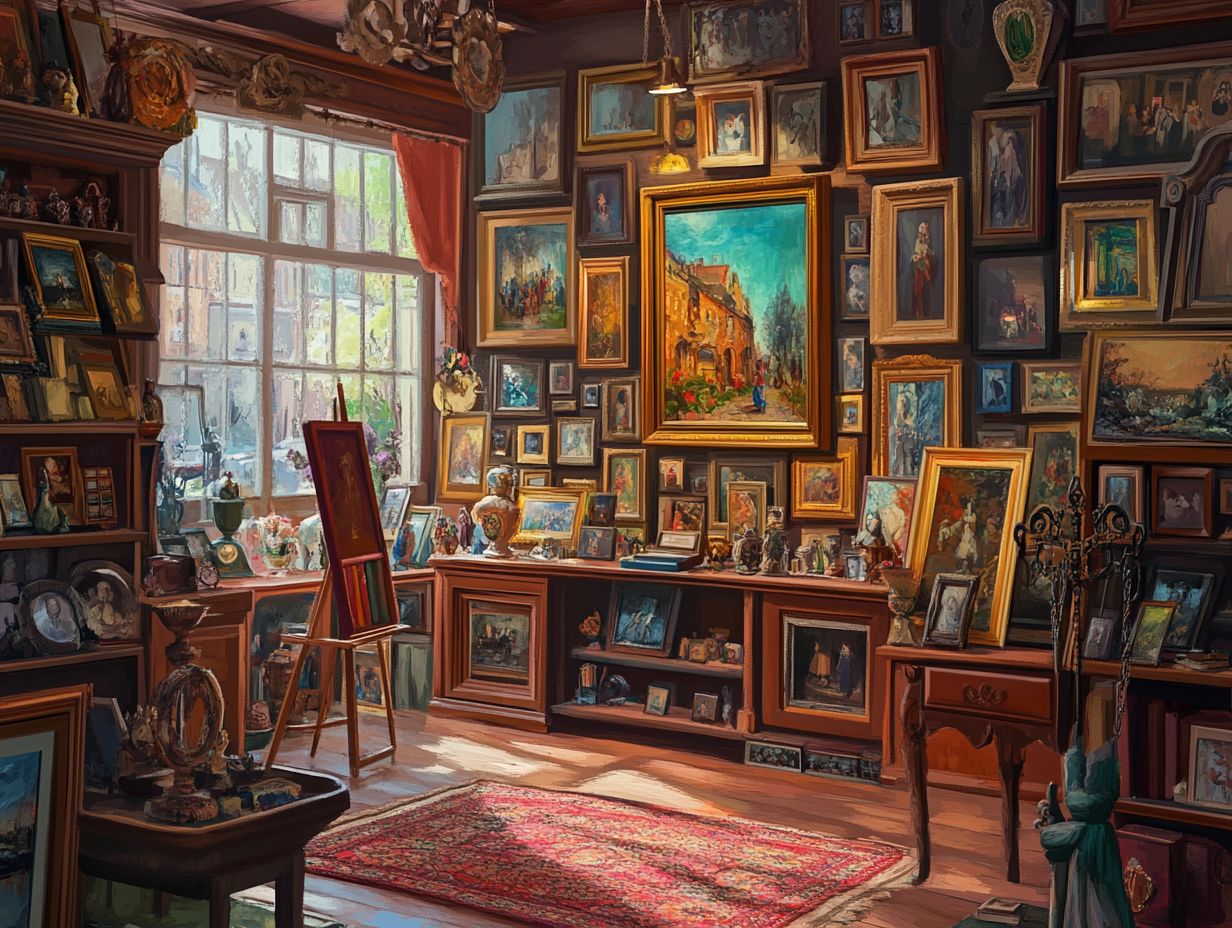
Qu es el arte de coleccionar?
El arte de coleccionar se refiere al proceso de adquirir y organizar objetos o art culos basados en un inter s, pasi n o tema espec fico. Implica una combinaci n de conocimiento, habilidad y preferencia personal para construir una colecci n.
C mo se puede equilibrar la pasi n y el beneficio en la colecci n?
Equilibrar la pasi n y el beneficio en la colecci n implica encontrar un balance entre adquirir art culos que realmente te apasionan y ser estrat gico sobre el valor y el potencial valor de reventa de esos art culos. Es importante no dejar que el beneficio potencial supere tu pasi n por coleccionar.
Cu les son algunos errores comunes a evitar en la colecci n?
Algunos errores comunes a evitar en la colecci n incluyen gastar en exceso o sobrevalorar art culos basados en el apego personal, no investigar lo suficiente sobre el valor y la autenticidad de los art culos, y no almacenar ni cuidar adecuadamente tu colecci n.
C mo puede uno determinar el valor de su colecci n?
El valor de una colecci n puede ser determinado por varios factores, como la rareza, la condici n, la demanda y la procedencia. Es importante hacer una investigaci n exhaustiva y buscar una tasaci n profesional si es necesario para determinar adecuadamente el valor de tu colecci n.
Cu les son algunos consejos para vender una colecci n?
Algunos consejos para vender una colecci n incluyen conocer el mercado de tus art culos, establecer un precio realista, publicitar y promover adecuadamente tu colecci n, y estar dispuesto a negociar con posibles compradores. Tambi n es importante tener una comprensi n clara del valor y el apego sentimental a tu colecci n antes de decidir vender.
C mo puede uno asegurar la preservaci n de su colecci n?
Para asegurar la preservaci n de una colecci n, es importante almacenar y cuidar adecuadamente los art culos. Esto puede incluir el uso de materiales de archivo, controlar la temperatura y la humedad, y revisar regularmente los art culos en busca de posibles da os.
Tambi n es importante tener un plan para el futuro de la colecci n, ya sea pas ndola a futuras generaciones o don ndola a un museo u organizaci n.
No esperes demasiado para evaluar tu colecci n! Cuanto antes act es, mejor podr prosperar tu colecci n.
Listo para comenzar tu colecci n? Vamos a sumergirnos!


